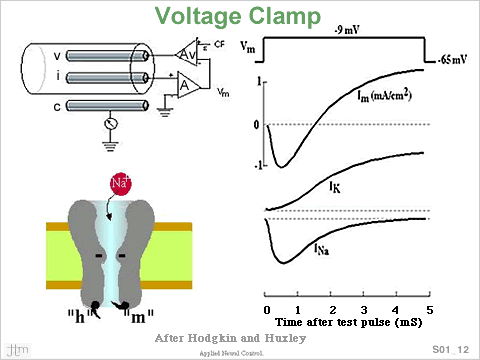|
 In an activated state, the Sodium
Channel permits Sodium ions to flow into the axon along its electrochemical gradient, giving rise to the 'Sodium' current. These transmembrane currents can be measured by the 'Voltage Clamp' technique. The membrane potential is monitored with a voltage amplifier (Av) between an electrode inside the axon (v) and ground. The membrane potential (Vm) is supplied to a feedback amplifier (A), which compares it to a 'command' voltage to control a current output to a second electrode inside the axon (i). By monitoring this current from an external electrode (c), a measurement is obtained of the current flowing through the membrane
Hodgkin and Huxley carried out voltage-clamp experiments that led to an understanding of how changes in ionic currents through the membrane gave rise to a propagated action potential. They also formulated a mathematical model to simulate the process. Hodgkin & Huxley dissected the transmembrane current into three components, a capacitive current, an inward current carried by sodium ions and an outward current carried by potassium ions. The sodium current leads to membrane depolarization and the potassium current leads to recovery of the membrane potential to resting levels. There are two distinct phases to the sodium current, the initial portion where the magnitude of the current increases and the second phase where the sodium current decreases. In the last ten to fifteen years the mechanism for this sodium channel behavior has become more understood. In an activated state, the Sodium
Channel permits Sodium ions to flow into the axon along its electrochemical gradient, giving rise to the 'Sodium' current. These transmembrane currents can be measured by the 'Voltage Clamp' technique. The membrane potential is monitored with a voltage amplifier (Av) between an electrode inside the axon (v) and ground. The membrane potential (Vm) is supplied to a feedback amplifier (A), which compares it to a 'command' voltage to control a current output to a second electrode inside the axon (i). By monitoring this current from an external electrode (c), a measurement is obtained of the current flowing through the membrane
Hodgkin and Huxley carried out voltage-clamp experiments that led to an understanding of how changes in ionic currents through the membrane gave rise to a propagated action potential. They also formulated a mathematical model to simulate the process. Hodgkin & Huxley dissected the transmembrane current into three components, a capacitive current, an inward current carried by sodium ions and an outward current carried by potassium ions. The sodium current leads to membrane depolarization and the potassium current leads to recovery of the membrane potential to resting levels. There are two distinct phases to the sodium current, the initial portion where the magnitude of the current increases and the second phase where the sodium current decreases. In the last ten to fifteen years the mechanism for this sodium channel behavior has become more understood.
Historical Note:
John Z. Young (~1930) introduced the use
of the giant squid axon with ~ 1mm diameter for study of
ion currents. Hodgkin
and Katz showed that Sodium ions were basic to AP
generation by making changes in the fluid bathing the axon.
In the forties, Kenneth
Cole developed the 'voltage clamp'. The
insertion of a long electrode inside the axon removed the
variable due to AP
propagation, maintaining equipotentiality inside the axon,
a 'space clamp'. In 1952 Hodgkin and Huxley published results
of their numerical model for action potential initiation
and propagation.
References:
Hodgkin, A.L., and Huxley, A.F. (1952). A quantitative description
of membrane current and its application to conduction and
excitation in nerve. J. Physiol. 117, 500–544.
Armstrong, C.M. (1981). Sodium channels and gating currents.
Physiol. Rev. 61, 644–682.
|

